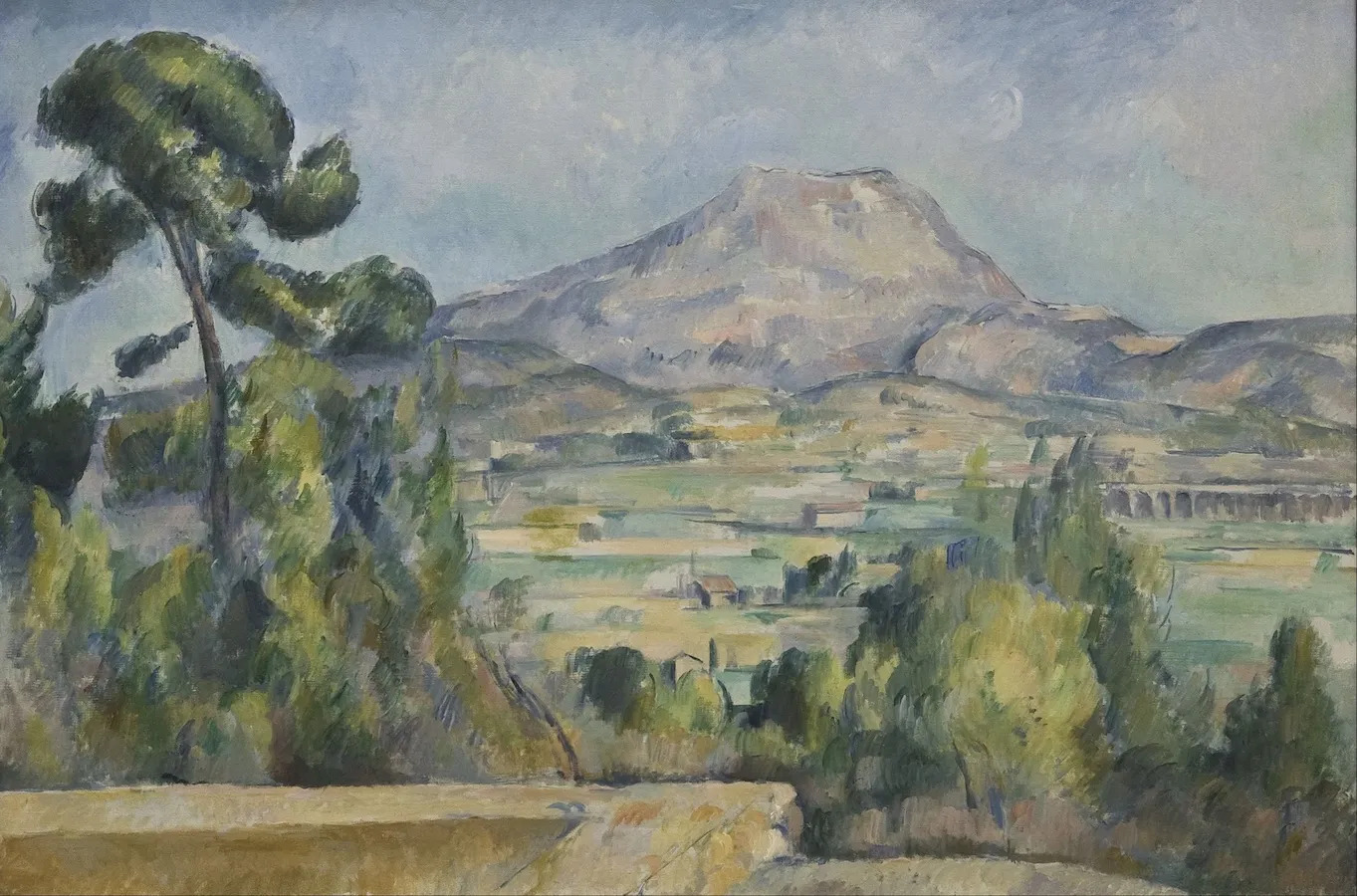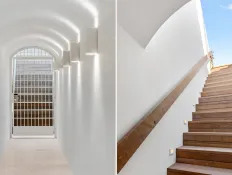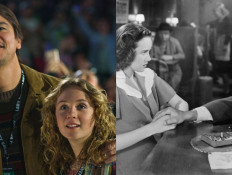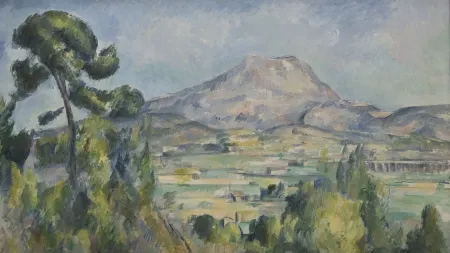
A spa city in the South of France founded by the Romans in 122 B.C., Aix-en-Provence is the birthplace of French painter Paul Cezanne (1839–1906). Ironically, however, until 1984 you could not view any of Cezanne’s works in his hometown; the unreceptive curator of the city’s Musée Granet at the time of Cezanne’s death famously declared that no works of the artist would ever be shown at the museum. But time passes, and today the Musée Granet holds more than a dozen of his works, including a landscape painted in the gardens of the local Le Pigonnet hotel.
Now comes the Year of Cezanne, which officially started on June 28 in the capital of the Provence region. L’Atelier des Lauves, the last studio where Cezanne worked, has been expanded and renovated. Similarly, Le Jas de Bouffan, his family home, is in the middle of a massive restoration. Both venues have partially reopened to the public for the Year of Cezanne; themed rides, tours, workshops, menus, and conferences have also been scheduled for the occasion.
Below is a sampling of notable sites and activities tied to the life and career of Paul Cezanne in Aix-en-Provence.
-
City Center

Image Credit: Aix-en-Provence Tourist Office. Photo: Sophie Spiteri. In the city center, a bronze statue of Cezanne by Gabriel Stark is a good starting point for a guided or self-directed tour that follows in the footsteps of the artist. Highlights of this quaint itinerary, composed by the tourist office, include the Église de la Madeleine, the church where Cezanne was baptized; the Collège Mignet, the middle school where he became friends with writer Émile Zola; and the house at 14 Rue Matheron, where he spent most of his youth, alternating with the Jas de Bouffan. It’s a walk full of discoveries that eventually leads to the artist’s last studio, L’Atelier des Lauves.
-
Jas de Bouffan

Image Credit: Aix-en-Provence Tourist Office. Jas de Bouffan is a 12.3-acre property acquired in 1859 by Louis-Auguste Cezanne, the artist’s father. In 2017 the city of Aix-en-Provence, its latest owner, decided to restore the property as closely as possible to its original state. The black-bordered skylight that stands out on the roof of the 19th-century bastide looks like it was built just yesterday, but it is exactly how Cezanne senior envisioned the source of light for his son’s studio. A few rooms, from the ground floor to a bedroom on the second believed to have been used by Madame Cezanne, is accessible to the public. The farmhouse to the left of the main building will soon house a research center, offices, and educational areas.
In August of 2024, during the renovation, pieces of an unknown composition were found under layers of wallpaper and plaster in the Grand Salon, the living area whose walls Louis-Auguste had given Paul carte blanche to paint. It appears to be a maritime scene, now referred to as Entrée du port (Entrance to the Port). Cezanne may also have partially painted over it with the work Jeu de cache-cache (Game of Hide and Seek) (1864). New owners likely covered over the remaining portions of Entrée du port after Cezanne and his sister sold the estate in 1899.
-
Atelier des Lauves

Image Credit: Aix-en-Provence Tourist Office. Every day, from 1902 to 1906, Paul Cezanne would visit this studio designed according to his specifications. This is where he painted The Large Bathers (1898–1905), among other works. In the past, visitors could access the second floor only, with items that belonged to the artist and others that evoked his work (easel, palette, brushes, pots, jugs, and so on). Work is now underway to spread the experience across the entire building. The first floor is divided into four rooms: one will focus on Cezanne’s relationship with his friends (Émile Bernard, Charles Camoin, Philippe Solari), another may be turned into a library, the third will feature items belonging to the painter, and the kitchen will look as it did in the early 20th century. The site will partially reopen this summer for the Year of Cezanne, then close its doors again for some finishing touches.
-
Musée Granet

Image Credit: Wikimedia Commons. Auguste-Henri Pontier, curator of the Musée Granet around the turn of the century, was apparently not a fan of Cezanne’s works and refused to add them to the museum’s holdings. Better late than never! Today, thanks to a series of donations, bequests, and long-term loans, the museum holds some 15 oils and watercolors by Cezanne. This summer it will present an exhibition of 130 works by the artist featuring his childhood’s home, the Jas de Bouffan, drawn from collections all over the world.
-
Carrières de Bibémus

Image Credit: Cezanne2025.com. Quarried since Roman times and especially in the 17th and 18th centuries, the Carrières de Bibémus provided the ocher limestone that covers most of the façades in the Mazarin district of Aix-en-Provence. Between 1895 and 1904, Cezanne regularly visited the quarry in search of inspiration. Reproductions of his works now occupy his favorite viewpoints. The shed where he would store his equipment is still standing. If you have three hours to spare, contact Pauline Bétrancourt, who gives watercolor lessons in the quarries, and also on the Plateau des Peintres and in the heart of the Saint-Victoire mountain range, often seen in Cezanne’s paintings.
-
Lodges Sainte-Victoire

Image Credit: Lodges Sainte-Victoire. Take the Route Cezanne, the only road listed as a historic monument in France, to the Lodges Saint-Victoire. The hotel is honoring Cezanne through a wide range of activities (yoga classes, musical readings, lectures, and more) in view of the painter’s favorite subject—the Montagne Sainte-Victoire, a mountain ridge featured in some 80 of his oils and watercolors. In the garden, you can enjoy a drink alongside a bronze bust of Cezanne by Chantal Tronquit. Chef Clément Huet has cooked up a menu in his honor, featuring langoustines, beef cheeks, apples, and pine nuts.
-
Cezanne’s go-to restaurants

Image Credit: Relais Cezanne. When painting in Le Tholonet, a town next to Aix-en-Provence, Cezanne would have lunch, alone or with friends, at Chez Rosa Berne. The restaurant, then named after its owner, is known today as the Relais Cezanne. The menu features a wide range of courses, including salads, braised meats, mixed platters, tartars, and pizzas. Another favorite spot of Cezanne’s was Les 2 Garçons, on 53 Cours Mirabeau in Aix-en-Provence. This former brasserie, where not only Cezanne but also actor Raimu and composer Darius Milhaud would stop by to eat, is currently being renovated but is due to reopen soon.
-
Le Pigonnet

Image Credit: Le Pigonnet. A former private home turned into a hotel in 1924, Le Pigonnet has always been a haven for artists. This 4.9-acre estate was initially designed as a folie,a countryside retreat surrounded by lush, manicured gardens where, rumor has it, Paul Cezanne would set up his easel to paint his beloved Sainte-Victoire. One of his works at the Musée Granet is thought to be proof of that. The five-star property now features 47 rooms and suites, two restaurants, a bar, and a spa.
-
Fondation Vasarely

Image Credit: Chris Hellier/Corbis via Getty Images. The work of Op Art icon Victor Vasarely may be light-years away from the paintings of Cezanne, but if you are in Aix-en-Provence celebrating the latter’s life and art, it would be a shame to miss the Fondation Vasarely, a striking modern structure next door to the Jas de Bouffan. The construction work, completed in 1976, gave rise to a 53,820-square-foot glass and aluminum building made up of 16 hexagons, which are a nod to hexagon-shaped France, where the Hungarian Vasarely settled in 1930. The ground floor houses 42 permanent “architectonic installations,” created for the museum and based on drawings by Vasarely, while the second floor is reserved for temporary exhibitions.
City Center

In the city center, a bronze statue of Cezanne by Gabriel Stark is a good starting point for a guided or self-directed tour that follows in the footsteps of the artist. Highlights of this quaint itinerary, composed by the tourist office, include the Église de la Madeleine, the church where Cezanne was baptized; the Collège Mignet, the middle school where he became friends with writer Émile Zola; and the house at 14 Rue Matheron, where he spent most of his youth, alternating with the Jas de Bouffan. It’s a walk full of discoveries that eventually leads to the artist’s last studio, L’Atelier des Lauves.
Jas de Bouffan

Jas de Bouffan is a 12.3-acre property acquired in 1859 by Louis-Auguste Cezanne, the artist’s father. In 2017 the city of Aix-en-Provence, its latest owner, decided to restore the property as closely as possible to its original state. The black-bordered skylight that stands out on the roof of the 19th-century bastide looks like it was built just yesterday, but it is exactly how Cezanne senior envisioned the source of light for his son’s studio. A few rooms, from the ground floor to a bedroom on the second believed to have been used by Madame Cezanne, is accessible to the public. The farmhouse to the left of the main building will soon house a research center, offices, and educational areas.
In August of 2024, during the renovation, pieces of an unknown composition were found under layers of wallpaper and plaster in the Grand Salon, the living area whose walls Louis-Auguste had given Paul carte blanche to paint. It appears to be a maritime scene, now referred to as Entrée du port (Entrance to the Port). Cezanne may also have partially painted over it with the work Jeu de cache-cache (Game of Hide and Seek) (1864). New owners likely covered over the remaining portions of Entrée du port after Cezanne and his sister sold the estate in 1899.
Atelier des Lauves

Every day, from 1902 to 1906, Paul Cezanne would visit this studio designed according to his specifications. This is where he painted The Large Bathers (1898–1905), among other works. In the past, visitors could access the second floor only, with items that belonged to the artist and others that evoked his work (easel, palette, brushes, pots, jugs, and so on). Work is now underway to spread the experience across the entire building. The first floor is divided into four rooms: one will focus on Cezanne’s relationship with his friends (Émile Bernard, Charles Camoin, Philippe Solari), another may be turned into a library, the third will feature items belonging to the painter, and the kitchen will look as it did in the early 20th century. The site will partially reopen this summer for the Year of Cezanne, then close its doors again for some finishing touches.
Musée Granet

Auguste-Henri Pontier, curator of the Musée Granet around the turn of the century, was apparently not a fan of Cezanne’s works and refused to add them to the museum’s holdings. Better late than never! Today, thanks to a series of donations, bequests, and long-term loans, the museum holds some 15 oils and watercolors by Cezanne. This summer it will present an exhibition of 130 works by the artist featuring his childhood’s home, the Jas de Bouffan, drawn from collections all over the world.
Carrières de Bibémus

Quarried since Roman times and especially in the 17th and 18th centuries, the Carrières de Bibémus provided the ocher limestone that covers most of the façades in the Mazarin district of Aix-en-Provence. Between 1895 and 1904, Cezanne regularly visited the quarry in search of inspiration. Reproductions of his works now occupy his favorite viewpoints. The shed where he would store his equipment is still standing. If you have three hours to spare, contact Pauline Bétrancourt, who gives watercolor lessons in the quarries, and also on the Plateau des Peintres and in the heart of the Saint-Victoire mountain range, often seen in Cezanne’s paintings.
Lodges Sainte-Victoire

Take the Route Cezanne, the only road listed as a historic monument in France, to the Lodges Saint-Victoire. The hotel is honoring Cezanne through a wide range of activities (yoga classes, musical readings, lectures, and more) in view of the painter’s favorite subject—the Montagne Sainte-Victoire, a mountain ridge featured in some 80 of his oils and watercolors. In the garden, you can enjoy a drink alongside a bronze bust of Cezanne by Chantal Tronquit. Chef Clément Huet has cooked up a menu in his honor, featuring langoustines, beef cheeks, apples, and pine nuts.
Cezanne’s go-to restaurants

When painting in Le Tholonet, a town next to Aix-en-Provence, Cezanne would have lunch, alone or with friends, at Chez Rosa Berne. The restaurant, then named after its owner, is known today as the Relais Cezanne. The menu features a wide range of courses, including salads, braised meats, mixed platters, tartars, and pizzas. Another favorite spot of Cezanne’s was Les 2 Garçons, on 53 Cours Mirabeau in Aix-en-Provence. This former brasserie, where not only Cezanne but also actor Raimu and composer Darius Milhaud would stop by to eat, is currently being renovated but is due to reopen soon.
Le Pigonnet

A former private home turned into a hotel in 1924, Le Pigonnet has always been a haven for artists. This 4.9-acre estate was initially designed as a folie,a countryside retreat surrounded by lush, manicured gardens where, rumor has it, Paul Cezanne would set up his easel to paint his beloved Sainte-Victoire. One of his works at the Musée Granet is thought to be proof of that. The five-star property now features 47 rooms and suites, two restaurants, a bar, and a spa.
Fondation Vasarely

The work of Op Art icon Victor Vasarely may be light-years away from the paintings of Cezanne, but if you are in Aix-en-Provence celebrating the latter’s life and art, it would be a shame to miss the Fondation Vasarely, a striking modern structure next door to the Jas de Bouffan. The construction work, completed in 1976, gave rise to a 53,820-square-foot glass and aluminum building made up of 16 hexagons, which are a nod to hexagon-shaped France, where the Hungarian Vasarely settled in 1930. The ground floor houses 42 permanent “architectonic installations,” created for the museum and based on drawings by Vasarely, while the second floor is reserved for temporary exhibitions.

Inside an $85 Million Palm Beach Estate With a Private Tunnel to the Ocean

The 13 Best Tennis Bracelets That’ll Become Your Everyday Jewelry Staples

What Happens To Your Consciousness After You Die?

Quintenz’s CFTC Nomination Paused by White House Intervention


